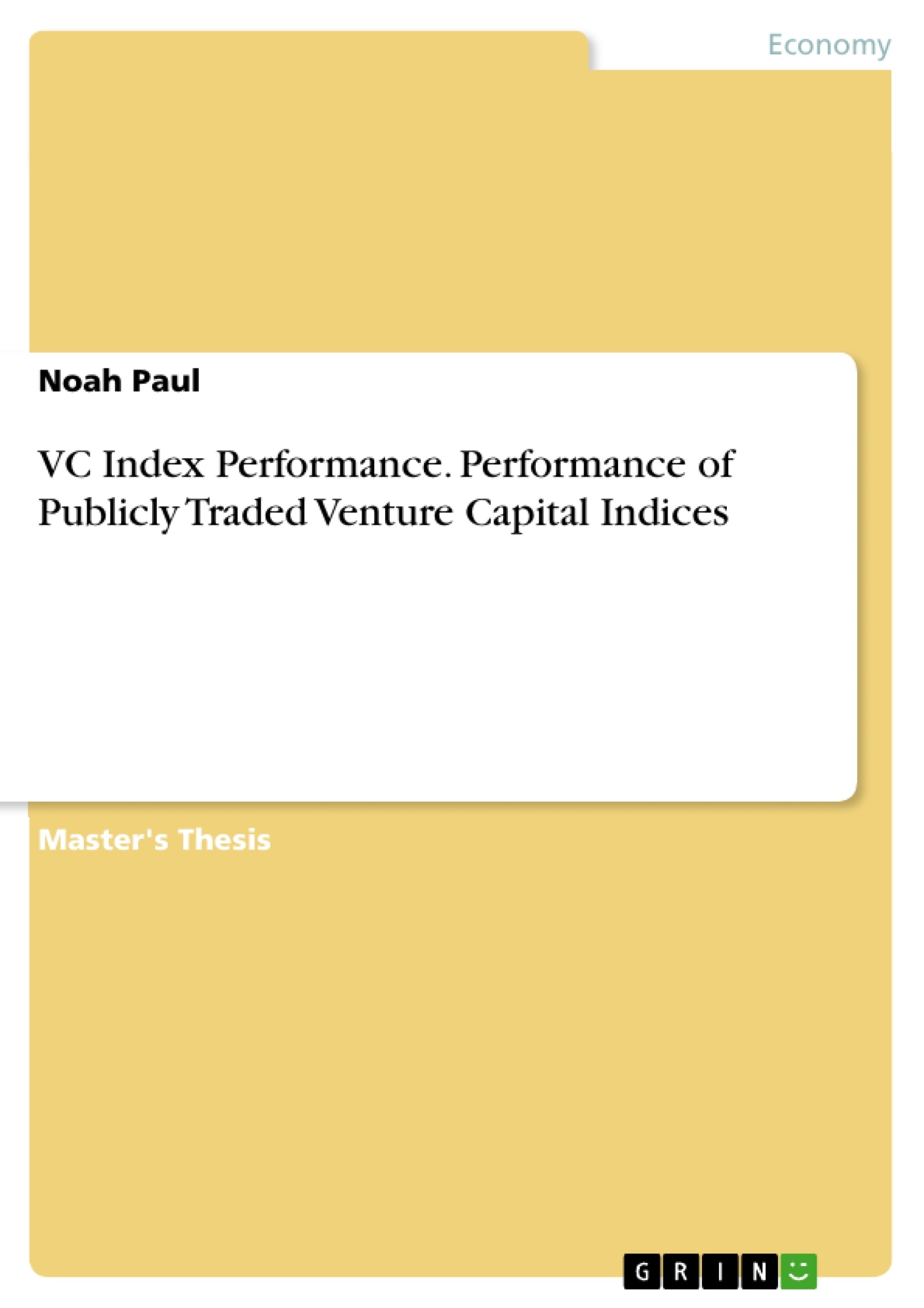
VC Index Performance. Performance of Publicly Traded Venture Capital Indices
Masterarbeit, 2021
77 Seiten, Note: 8.1/10
Leseprobe
Table of Contents
- CHAPTER 1: INTRODUCTION
- 1.1 Venture Capital
- 1.2 Index
- 1.3 Mutual Funds
- 1.4 Venture Capital Index background
- 1.4.1 Thomson Reuters Post Venture Capital Index (PVCINDX)
- 1.4.2 Thomson Reuters Research & VC index (TRVCINX)
- 1.5 Relevance
- 1.6 Research Objectives
- 1.7 Research Question
- 1.8 Summary
- CHAPTER 2: LITERATURE REVIEW
- 2.1 Venture Capital returns
- 2.2 Mutual Fund Performance
- 2.2.1 The Sharpe Ratio
- 2.2.2 Jensen's Alpha
- 2.3 The efficient market hypothesis
- 2.4 Hypotheses
- CHAPTER 3: METHODOLOGY
- 3.1 Research Design
- 3.2 Data sources
- 3.3 Methodology
- 3.3.1 The Sharpe Ratio
- 3.3.2 Jensen's Alpha
- CHAPTER 4: RESULTS & DISCUSSIONS
- 4.1 Absolute Performance
- 4.2 Sharpe findings
- 4.2.1 Monthly Sharpe Ratio findings
- 4.2.2 Annual Sharpe Ratio findings
- 4.3 CAPM & Jensen's Alpha findings
- 4.3.1 Thomson Reuters Venture Capital Index (TRVCINX) Regression findings
- 4.3.2 Thomson Reuters Post Venture Capital Index (PVCINDX) Regression findings
- 4.3.3 Macroeconomic impact on VC Index Regression findings
- 4.4 Hypothesis discussion
- 4.4.1 H₁: The Venture Capital indices gross returns will exhibit lesser Sharpe ratio's than the Market benchmarks
- 4.4.2 H₂: The Venture Capital indices net returns will exhibit lesser Sharpe ratio's than the Market benchmarks
- 4.4.3 H3: The Venture Capital indices gross returns will exhibit no positive alpha when regressed against Market Benchmarks returns
- 4.4.4 H: The Venture Capital indices net returns will exhibit no positive alpha when regressed against Market Benchmarks returns
Objectives and Key Themes
This study aims to analyze the performance of publicly traded Venture Capital (VC) indices since their public availability in 2012, specifically investigating whether these indices provide attractive returns or outperform the market. The research utilizes archival price data from 1995-2021, employing the Sharpe ratio and Jensen's alpha to assess performance.
- Performance of publicly traded Venture Capital indices.
- Comparison of VC index returns to market benchmarks.
- Application of the Sharpe ratio and Jensen's alpha to evaluate risk-adjusted returns.
- Analysis of the relationship between VC index performance and macroeconomic factors.
- Testing of hypotheses regarding the performance of VC indices against market benchmarks.
Chapter Summaries
CHAPTER 1: INTRODUCTION: This chapter introduces the concept of Venture Capital, indices, and mutual funds, providing background on the Thomson Reuters Post Venture Capital Index (PVCINDX) and the Thomson Reuters Research & VC index (TRVCINX). It establishes the relevance of studying VC index performance, defines the research objectives and question, and outlines the chapter's structure. The introduction sets the stage for the empirical analysis by highlighting the novelty of publicly available VC indices and the lack of conclusive research on their market performance. It establishes a clear research gap and proposes to address it through rigorous quantitative analysis.
CHAPTER 2: LITERATURE REVIEW: This chapter reviews existing literature on venture capital returns, mutual fund performance (including the Sharpe ratio and Jensen's alpha), and the efficient market hypothesis. It lays the groundwork for the study's hypotheses by examining prior research findings on related topics and establishing a theoretical framework. The review critically evaluates different methodologies and findings in the literature, identifying potential shortcomings and informing the design of the current study. This provides context for the study’s methodological choices and expected outcomes. It also explicitly states the hypotheses that will be tested in the subsequent chapters.
CHAPTER 3: METHODOLOGY: This chapter details the research design, data sources, and methodology employed in the study. It explains the specific application of the Sharpe ratio and Jensen's alpha in assessing the performance of the VC indices. The methodology is meticulously explained, outlining the data collection procedures, statistical techniques, and analytical framework used to test the stated hypotheses. The clear and detailed description of this section is vital for ensuring the reproducibility and validity of the research findings. The selection of specific metrics and their application are thoroughly justified and discussed.
CHAPTER 4: RESULTS & DISCUSSIONS: This chapter presents the results of the empirical analysis, including absolute performance figures, Sharpe ratio findings (both monthly and annual), and CAPM (Capital Asset Pricing Model) and Jensen's alpha findings for both VC indices. It presents a comprehensive discussion of the findings in relation to the stated hypotheses, analyzing the performance of both the TRVCINX and PVCINDX indices relative to market benchmarks. The chapter meticulously presents and discusses the results of the regression analyses, examining the statistical significance of the findings and their implications for the understanding of VC index performance. It concludes with a detailed discussion of the hypothesis tests, assessing whether the data supports or refutes the initial hypotheses.
Keywords
Venture Capital, Index Funds, Sharpe Ratio, Jensen's Alpha, Market Benchmark, Risk-Adjusted Returns, Thomson Reuters VC Index, Empirical Research, Investment Management, Financial Performance
Frequently Asked Questions: Analysis of Publicly Traded Venture Capital Indices
What is the main topic of this research paper?
This research paper analyzes the performance of publicly traded Venture Capital (VC) indices, specifically the Thomson Reuters Post Venture Capital Index (PVCINDX) and the Thomson Reuters Research & VC index (TRVCINX), since their public availability in 2012. It investigates whether these indices provide attractive returns or outperform the market, comparing their performance to market benchmarks.
What time period does the research cover?
The research utilizes archival price data spanning from 1995 to 2021.
What methodologies are used to assess the performance of the VC indices?
The study employs the Sharpe ratio and Jensen's alpha to assess the risk-adjusted returns of the VC indices. It also uses regression analysis to examine the relationship between VC index performance and macroeconomic factors.
What are the key indices analyzed in this study?
The primary indices analyzed are the Thomson Reuters Post Venture Capital Index (PVCINDX) and the Thomson Reuters Research & VC index (TRVCINX).
What are the main research questions or objectives?
The research aims to determine if the VC indices provide attractive returns compared to market benchmarks, and whether they exhibit positive alpha (outperformance). It also investigates the impact of macroeconomic factors on VC index performance.
What hypotheses are tested in this research?
The research tests hypotheses related to the Sharpe ratios (both gross and net returns) of the VC indices compared to market benchmarks, and whether the indices exhibit positive alpha when regressed against market benchmark returns.
What data sources were used in this study?
The chapter on Methodology details the specific data sources used, although the exact sources aren't explicitly listed in the provided preview.
What are the key findings of the study (as presented in the preview)?
The preview summarizes that Chapter 4 presents the results of the empirical analysis, including absolute performance, Sharpe ratio findings (monthly and annual), and CAPM and Jensen's alpha findings for both VC indices. It also includes a discussion of the findings in relation to the stated hypotheses.
What are the key themes explored in this research?
Key themes include the performance of publicly traded Venture Capital indices, the comparison of VC index returns to market benchmarks, the application of the Sharpe ratio and Jensen's alpha, the analysis of the relationship between VC index performance and macroeconomic factors, and testing hypotheses regarding the performance of VC indices against market benchmarks.
What are the keywords associated with this research?
Keywords include Venture Capital, Index Funds, Sharpe Ratio, Jensen's Alpha, Market Benchmark, Risk-Adjusted Returns, Thomson Reuters VC Index, Empirical Research, Investment Management, and Financial Performance.
What is the structure of the research paper?
The paper is structured into four chapters: Chapter 1 (Introduction), Chapter 2 (Literature Review), Chapter 3 (Methodology), and Chapter 4 (Results & Discussions). Each chapter's summary is provided in the preview.
Details
- Titel
- VC Index Performance. Performance of Publicly Traded Venture Capital Indices
- Hochschule
- TiasNimbas Business School
- Veranstaltung
- Investment Management
- Note
- 8.1/10
- Autor
- Noah Paul (Autor:in)
- Erscheinungsjahr
- 2021
- Seiten
- 77
- Katalognummer
- V1404592
- ISBN (Buch)
- 9783346955142
- Sprache
- Englisch
- Schlagworte
- VC Venture capital index indices
- Produktsicherheit
- GRIN Publishing GmbH
- Preis (Ebook)
- US$ 32,99
- Arbeit zitieren
- Noah Paul (Autor:in), 2021, VC Index Performance. Performance of Publicly Traded Venture Capital Indices, München, Page::Imprint:: GRINVerlagOHG, https://www.diplomarbeiten24.de/document/1404592
- Autor werden
- Ihre Optionen
- Vertriebskanäle
- Premium Services
- Autorenprofil
- Textarten und Formate
- Services für Verlage, Hochschulen, Unternehmen

- © GRIN Publishing GmbH.
- Alle Inhalte urheberrechtlich geschützt. Kopieren und verbreiten untersagt.
- info@grin.com
- AGB
- Open Publishing
Der GRIN Verlag hat sich seit 1998 auf die Veröffentlichung akademischer eBooks und Bücher spezialisiert. Der GRIN Verlag steht damit als erstes Unternehmen für User Generated Quality Content. Die Verlagsseiten GRIN.com, Hausarbeiten.de und Diplomarbeiten24 bieten für Hochschullehrer, Absolventen und Studenten die ideale Plattform, wissenschaftliche Texte wie Hausarbeiten, Referate, Bachelorarbeiten, Masterarbeiten, Diplomarbeiten, Dissertationen und wissenschaftliche Aufsätze einem breiten Publikum zu präsentieren.
Kostenfreie Veröffentlichung: Hausarbeit, Bachelorarbeit, Diplomarbeit, Dissertation, Masterarbeit, Interpretation oder Referat jetzt veröffentlichen!
- GRIN Verlag GmbH
-
- Nymphenburger Str. 86
- 80636
- Munich, Deutschland
- +49 89-550559-0
- +49 89-550559-10
- info@grin.com
-









